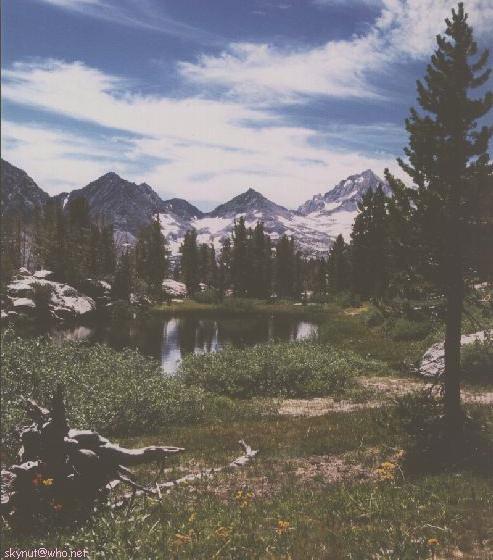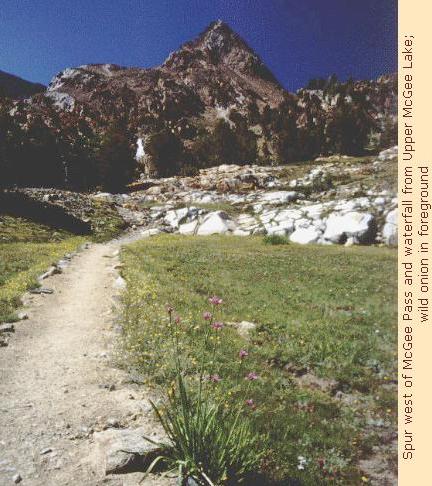
Little Lakes Valley

tarn along Mono Pass Trail
|
Day One: We started late, re-packing our gear and finding the main parking lot full at the trailhead. Once under way we enjoyed the wondrous views up Little Lakes Valley, which terminates in a wall of 13,700-foot peaks.
Since the trailhead is over 10,000 feet it doesn't sound like much, but the walls around the valley are extremely beautiful! We moved slowly from both the strain of packs and the photo-ops but finally reached Ruby Lake, where we shed the packs and strolled up for the great views. Re-shouldering our burdens, we zigzagged up to Mono Pass at 12,050 feet. The views are limited at the pass, but after turning the corner below Summit Lake the northward view was a shock. Several multi-hued peaks pierced the cirrus-strewn sky, appearing too steep to remain upright: Red and White Mountain, Red Slate Mt., and Mt. Baldwin were extremely photogenic. One of our day-trips was to reach the summit of Red Slate; from our first view we knew that would be asking quite a lot, since it looked steep and slick with sliding rock. That was for a later time; for now it was time to get low and find a camp to rest our weary bodies. By 6pm we were at the end of the steep stretch, sitting at just over 10,000 feet on Golden Creek. Larry hunted upstream for a campsite while I forced oxygen out of the thin air. He found a great one close by, and the fire did us both good. Dinner was a hearty chicken stew with a spot of tea from Larry's supply.
|
|---|
|
Day two: My snoring drove Larry in search of quieter sleeping-quarters, and he woke up feeling the altitude. I felt worse on day one and a bit better this day, but the view west was disquieting. At 8am large cumulus clouds were already visible and drifting from the south. Some tropical air had apparently outflanked the 10-day forecast and was building towering clouds very early in the day. We filled up as best we could at breakfast, then headed down the long trail that a six-day schedule required of us. The thunder waited for us to reach the relative safety of taller trees before grumbling overhead, and a heavy shower passed behind us as we worked our way down-valley. The aftereffects were less pleasant: we toiled up a short slope under heavy, humid air that held neither cool breeze nor refreshing rain. We were again wearing out when we joined the Muir Trail in its northward march to Pocket Meadow. We stopped at the first possible place, but again Larry's scouting skills found a better site a few minutes ahead. Dinner this night was a turkey tetrazinni; I must have been tired because I still can't clearly remember how good it was. We also threw in some soup, which our bodies made good use of. I started the night without the rain-tarp under clear skies but awoke to more fast-moving clouds from the south at 4am. I hastily covered the tent and warned Larry, who was peacefully resting among the trees. No rain found us overnight, however.
|
|

view S from Silver Pass

view W from Silver Pass
|
Day three: Eager for the high-elevation views, we resumed the tour around 8:30 after Larry tried out his one-day license on the local fish. Climbing rapidly past a pretty waterfall, we leveled out in a meadow with a sluggish stream full of fish. The hike was cutting into Larry's fishing day, and the promise of 'sometimes excellent' fishing at Tully Lake kept us (him) moving. We cleared the trees near Silver Pass Lake and met our first and only person doing the entire 200+ miles of the Muir Trail there. Climbing past the lake we encountered stunning scenery at the top of Silver Pass. We must have been stunned, since we didn't move from there for at least half an hour! After dozens of photos in all directions, we plunged over the north-facing snowpatch and descended into the Fish Creek drainage. A long, dry stretch followed with occasional views of the Minarets and Mt. Ritter / Banner Peak, leading ever downward to the upper fork of Fish creek. We resumed climbing at the fork, reaching Tully Hole in midafternoon. We could have comfortably stopped anywhere past Tully Hole, but Larry's mind and feet were set on Tully Lake, so three more miles stretched before us. The first crossing of upper Fish Creek was on a huge log, so we were shocked when the second crossing was wide open, with no log to be seen. We found a narrow, shaky, knot-covered one a bit upstream, and it brought my minimal training clearly to mind. Undo the waist-strap, protect your valuable things from the water, those kind of things. A clump of shrubbery on the other side called to me, and I tossed my water-bottle pouch across the narrow but deep creek. It landed so gently that I couldn't resist the potential danger, so I g e n t l y tossed my camera into the same place. It bounced off the shrubs, rolled down the hill and plopped into the creek, bobbing gently while it filled with water. I shot across the log hastily and scooped up the camera case, cursing my luck and forgetting how tricky that log was to cross. Winding the film and pulling the battery, I opened up the camera and put it on my pack in full sunlight, and waited for the results.
|
|---|
|
The trail steepened in a hurry, draining our last calories in the late afternoon, then leveled out near 6pm when we reached the Tully Lake cutoff. Crawling over large talus and up steep meadows, Larry reached the lake quickly and found us a high campsite while I crumpled at the shoreline. A few minutes later we were setting up camp above the lake near a lazy inlet stream, with Red Slate Mountain dominating the northeast skyline. That could wait for tomorrow; tonight's task was to keep the reluctant water-filter pumping while Larry used his fishing license before sunset. The camp was ready for him when he came back at dusk with two 10-inch trout [two more got away], so our noodles and chicken was well-supplemented by pan-fried trout that night. The bear problem was still on our minds, so Larry started a small fire to burn the leftovers while we scrubbed the fish smell off our pots and faces. My gloves smelled a bit fishy so I left them well away from the camping area. It was fully dark by this time, so we watched the stars for meteors [we never saw a one on this whole trip..] before going to bed.
|
|

Silver Divide from McGee Pass Trail

peak and waterfall near Big McGee Lake
|
Day Four started cold. My feet were cold all night, and the ice in the water-bucket gave a good explanation for our slow start this morning. We could finally afford it: this day's work would be less than five miles, although we did have some vertical distance to cover to reach 11,850-foot McGee Pass. Larry took some sunrise shots while I pointed my photo equipment at the sun [fog between the lens-elements told me that it was still holding water]. While I failed to see Larry's ballet act, he came back with an impressive gash on his leg from rolling gently off a chunk of granite. We covered the Tully Lake trail much faster this morning, then turned east into a scenic wonderland. High meadows, wildflowers, the red slate from the well-named peak, and the ragged crest of the Silver Divide combined for a morning of exquisite views and active cameras [I was improvising with meter-readings from Larry]. After a healthy climb we reached the top and huddled on the far side to evade the chill wind that had ushered us to the pass. Others coming up the east side noted that several snowfields awaited us on the downslope; after a bit of lunch we confronted the large patches and negotiated a safe descent.
Looking at us from the south side of the valley, Hopkins Pass sported large snowfields of its own, crowned with a huge cornice. The look of that was decidedly unpleasant, and we spoke of our few alternatives to that route. Only one option, really, and it took us down the wrong valley to a spot both remote and far from the car. In the meantime, the view opened up toward Big McGee Lake and the rest of the valley. We reached the lake and turned toward Hopkins Pass, looking for a good camp and a place to examine the pass more closely. A beautiful camp awaited us under the pines near the smaller lake, and our 3pm arrival left us with time to relax and clean everything we possessed. I chose the stream for refreshment and Larry chose the big lake; he reported a 16-18" trout sharing his swimming area!
Since it was our niece's birthday we splurged on dinner, with Chicken Rotelle and tea or punch followed by soup and a chocolate mousse pie for dessert, followed by a Yukon Jack toast [we had sampled the liquor each day to be sure it was safe to drink]. Larry went up-valley afterward to check tomorrow's route while I turned in early. He learned several things, most notably about how not to cut willow saplings: his finger bled a lot longer than he thought it would.
|
|---|





